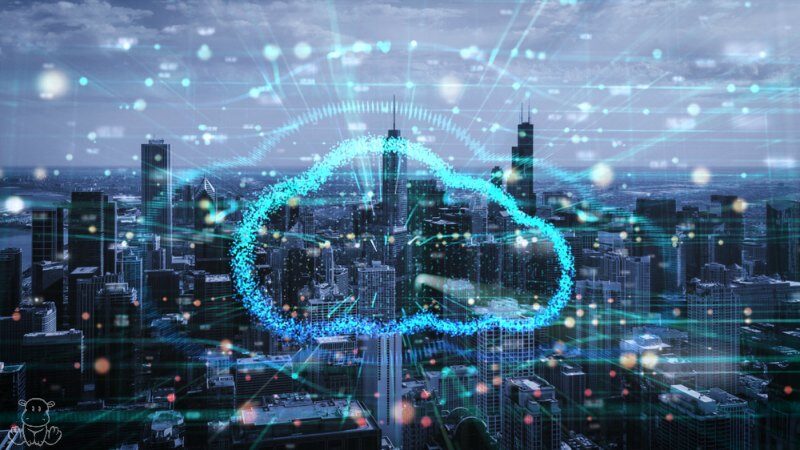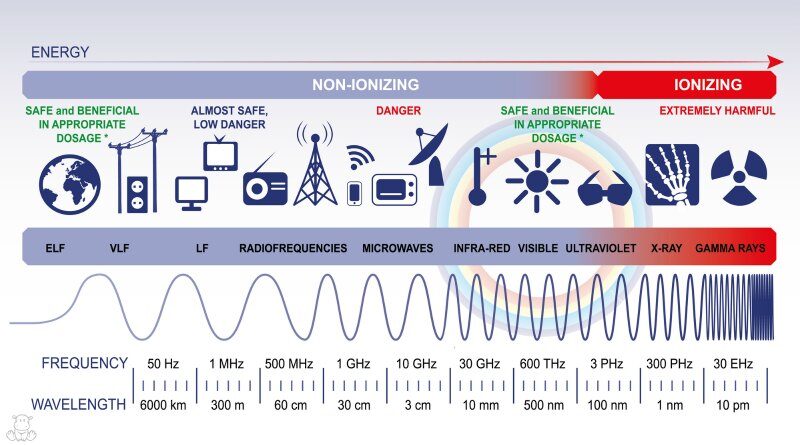
A few weeks ago, 5G cell towers began popping up in my community, shortly after the governor of my state signed a bill that took away the right of individual cities to oppose them. Local governments are pushing back, though – not just in my area, but around the world. Some cite health concerns, while others consider them an eyesore that could diminish property values.
So what do we know about 5G, how does it compare with other types of EMF exposure, and most importantly, is 5G safe?
In this article, we’ll dive into those questions, plus:
- What renowned international scientists and physicians have to say
- Insights into biological effects from peer-reviewed research
- Why 5G may be worse than 2G, 3G, 4G and wifi
- Environmental effects
- What safety testing that has been done (and what hasn’t)
- Steps we can take
Before we dive in, I know this is a tough subject and I applaud you for taking the time to educate yourself.
Important Note: Starting tomorrow, you can access free expert advice on simple, empowering steps you can take to reduce EMFs in your family’s life, plus insights into how groups and individuals are opposing 5G. More info here.

So, what is 5G?
My eyes usually glaze over when people start saying things like “network latency,” so I’m going to try to keep this simple.
5G (5th generation) technology is a super fast network that promises to reduce latency (there’s that word again) from 30-50 milliseconds to 1 millisecond. The increase in browsing speed will be barely noticeable to us, but it will give machines the ability to talk to each other almost seamlessly.
That’s significant because the 5G rollout is not really about browsing speeds – it’s designed to connect the Internet of Things (IoT) – a term that basically means connecting your coffee maker, washing machine, toothbrush, smartphone, headphones, FitBit, home security cameras, lamp, climate control, and about 26 billion other devices to the internet. (1) Yep, billion with a B.
Now, you already know that the electromagnetic spectrum is broken up into bands including non-ionizing radiation (radio waves, microwaves, infrared light, visible light, near ultraviolet) and ionizing radiation (far ultraviolet, x-rays and gamma rays). Current technologies use radio frequencies in the lower band range (below 6 gigahertz), but 5G networks will utilize ultra high frequency microwaves and millimeter waves (30 to 300 gigahertz) on the spectrum.
These higher frequencies can only travel short distances and are easily absorbed by plants, rain, and other materials, which can cause signal interference. To overcome that, the wireless industry plans to install millions of mini cell towers where we live, work, and go to school.
Again, the promise is more speed and convenience. But with all that 5G might be able to do FOR US, many scientists and physicians have serious concerns about what it can do TO US.
Independent Scientists Warn Governments (And Us) About 5G
In 2017, a group of international scientists and physicians issued an appeal to the European Union, urging them to halt the rollout of 5G until the potential hazards to human health and the environment could be fully investigated.
According to them, current safety guidelines protect industry, not human health, and harmful effects from radiofrequency (RF) exposure via 2G, 3G, 4G and wifi technology are already proven. Although some governments are listening, most aren’t, so the scientists are bringing their concerns directly to us.
For example, this week I read 127 page report from Dr. Martin Pall, Professor Emeritus of Biochemistry at Washington State University, on the the risks of 5G. Dr. Pall, who holds a bachelors degree in physics from Johns Hopkins University and a PhD in Biochemistry & Genetics from Caltech, first submitted a shorter version of the report to authorities within the European Union. (It’s since been expanded with more commentary and research references.)
In it, Dr. Pall argues that the main document used to guide policy about EMF safety – SCENIHR 2015 – leaves out crucial studies that show evidence of harm. (3) If you’d like a copy, you can download it for free when you sign up for the 5G Crisis Summit that is streaming for free this week.
We’ll dive into what Dr. Pall says about 5G specifically later in this article, but first let’s dive into what those omitted studies say, and why some experts think regulatory agencies such as the FCC may be reluctant to acknowledge health risks associated with EMFs.

“Troubling Body of Evidence” Suggests Health Risks
Current EMF safety guidelines are based only on the heating (thermal) effects, because when they were created it was assumed that electromagnetic radiation had no other effects. Even when scientists started reporting non-thermal effects, critics expressed doubt about their validity by saying that there was “no known mechanism” which could be causing them.
Well, now there is.
In a groundbreaking paper published in 2013, Dr. Pall showed that EMFs can activate microscopic sensors on our cells called voltage gated calcium channels (VGCCs), leading to distinct downstream biological effects including:
- DNA breaks (both single strand and double strand)
- Oxidative stress
- Lowered fertility
- Reduced production of steroid hormones including estrogen, progesterone and testosterone
- Melatonin depletion leading to sleep problems
- Neurological and neuropsychiatric problems
- Fatigue
- Headaches
- Difficulty concentrating
- Memory problems
- Stress and anxiety
- Cancer (3) (4) (5)
His conclusions are far from alone. A Harvard report we’ll discuss cites a “troubling body of evidence” which shows that EMF exposure increases the risk of brain cancer, depressive tendencies, concentration difficulties, irritability, memory loss, dizziness, lower libido, altered neurotransmitter function, increased blood-brain barrier permeability, and altered gene expression.” (6)
So why isn’t this research causing regulatory organizations to create more stringent safety standards?
According to Joel Moskowitz, director of the Center for Family and Community Health at the University of California-Berkeley‘s School of Public Health:
The industry is basically using the tobacco industry playbook.” (6)
Harvard Report Calls FCC a “Captured Agency”
In a report called “Captured Agency: How the Federal Communications Commission Is Dominated by the Industries It Presumably Regulates,” the Safra Institute for Ethics at Harvard University says the FCC has allowed the wireless industry “to grow unchecked and virtually unregulated, with fundamental questions on public health impact routinely ignored.”
They describe the FCC as a captured agency, which they define as the following:
Captured agencies are essentially controlled by the industries they are supposed to regulate. A detailed look at FCC actions—and non-actions—shows that over the years the FCC has granted the wireless industry pretty much what it has wanted.” –
So why aren’t these studies causing regulatory organizations to create more stringent safety standards? In the book, Doubt Is Their Product: How Industry’s Assault on Science Threatens Your Health, George Washington University Professor Dr. David Michaels argues that industries intentionally skew scientific literature in order to cast doubt on the health effects of their products so that they can derail government regulation. He describes how the tobacco industry playbook – which had a pattern of dismissing good scientific research as “junk science” – has been adapted for use in many other industries such as lead, asbestos and the pharmaceutical industry, specifically with respect to Vioxx.
There certainly seems to be a possibility of biased research within the wireless industry. According to this analysis published in the Journal of Environmental Health Perspectives, studies funded by the wireless industry only showed a biological effect on human beings about 28% of the time. In contrast, the studies funded by other sources (that are presumably more independent) showed an effect 68% percent of the time.
Speaking of studies . . .
How Many Safety Studies Have Been Done On 5G?
According Physicians for Safe Technology, none.
None are planned, either. In the short video below, Senator Blumenthal questions Brad Gillen, a representative of the lobbying arm of the wireless industry, on whether they have allocated any funds toward independent study of 5G safety. The answer? No.
Why 5G May Be Much Worse Than 3G, 4G & Wifi
According to Dr. Pall, there are four reasons 5G technology is likely to have much more of a biological impact than current technologies.
1. The sheer number of mini cell towers that are planned will increase our exposure. As Desiree Jaworski, executive director of the Center for Safer Wireless, told the LA Times, “Right now, you don’t have to live next to a cell tower. If you’re concerned about it, you can move away . . . But once they have these cell antennas everywhere, you won’t be able to do that.”
2. Carriers need to use very high outputs to ensure signal penetration into buildings.
3. 5G networks pulse information at extraordinarily high levels. A high pulse rate increases the biological effect of EMFs. (3)
4. Because the wavelengths used are easily absorbed, they are likely to be particularly active in stimulating our cells’ voltage sensors. As described above, Pall has connected voltage sensor activation with multiple health effects.
What about claims that 5G radiation isn’t well-absorbed by the body?
The industry has also made claims that more conventional microwave frequency EMFs are limited in effect to the outer 1 cm of the body. We know that this is not true, however because of the effects deep in the human brain, on the heart and on hormone systems. Perhaps the most important two studies demonstrating effects deep within the body are the studies of Professor Hassig and his colleagues in Switzerland on cataract formation in newborn calves [137, 138].
These two studies clearly show that when pregnant cows are grazing near mobile phone base stations (also called cell phone towers), the calves are born with greatly increased incidences of cataracts. It follows from these findings that even though the developing fetuses are very deep in the body of the mother and should be highly protected from the EMF exposures, they are not so protected.” – Dr. Martin Pall (3)
He offers a couple of ideas on how the deeper effects could be happening:
- The “magnetic parts of the EMFs have been known for decades to penetrate much more deeply than do the electrical parts.”
- “Because the voltage sensor is so stunningly sensitive to electrical forces and part of the reason for that is the very high level of amplification of the electrical field across the plasma membrane, we have an almost perfect way in which to produce EMF effects deeply within our bodies.”

Possible Environmental Effects of 5G
In addition to worries over human health, there are concerns that 5G service could have unintended environmental impacts, too. Studies have shown that radiofrequency radiation and other types of EMF affect plants (including food crops) and animals including bees needed to pollinate, so some believe they have the potential to impact natural ecosystems, too.
According to Pall, it’s possible that “many organisms will be much more impacted than we will. This includes insects and other arthropods, birds and small mammals and amphibia. It includes plants including even large trees, because trees have leaves and reproductive organs that are highly exposed.”(3) Others agree, for example:
- “This 2010 study showed that the leaves of aspen seedlings exposed to RFR exhibited symptoms of necrosis, while another Armenian study suggested low-intensity MMW’s cause “peroxidase isoenzyme spectrum changes”–basically a stress response that damages cells–in wheat shoots.” (7)
- In this study, it was noted that “Tops of trees tend to dry up when they directly face the cell tower antennas. . . . A study by the Centre for Environment and Vocational Studies of Punjab University noted that embryos of 50 eggs of house sparrows were damaged after being exposed to mobile tower radiation for 5-30 minutes. . . . In a study on cows and calves on the effects of exposure from mobile phone base stations, it was noted that 32% of calves developed nuclear cataracts, 3.6% severely.”
Some Cities Halt 5G Rollout
Last April, the Belgian government halted a 5G test in Brussels over concerns about health risks. In the Netherlands, members of Parliament are urging the government to an independent conduct safety study before installing 5G. According to this news article that I was able to read via Google Translate, local media is citing “scientific studies that indicate a possible correlation of radiation with brain tumors, Alzheimer’s disease and infertility in men.”
In Mill Valley, California, which is just outside of Silicon Valley, residents blocked the rollout of 5G over cancer concerns. According to the Wall Street Journal, “Residents of Portland, Ore., and Whitefish, Mont., have also cited these beliefs while lobbying for restrictions. Legislators in four states including New Hampshire have proposed bills that would mandate further study of health effects or else urge Congress to do so, and Congressman Thomas Suozzi (D., N.Y.) wrote to the FCC echoing these concerns.” (2)
Also, more than 90 cities and counties have joined together in a lawsuit against the FCC, whom they claim has overstepped by trying to take power away from local governments to decide where and how 5G is rolled out.(2)
What You Can Do
Many locals, including myself, are working with our city government to restore local authority and challenge the rollout. Some of us are concerned about health risks – which independent scientists have warned us about – and others consider them an eyesore that could diminish property values.
I’m still researching the best ways to take action, and I’ll be updating this section as I learn more. In the meantime, I highly recommend signing up for FREE access to 5G Crisis: Awareness and Accountability. It’s an online summit that’s starting tomorrow and goes through September 7, and it promises to cover:
- Science about the dangers of 5G and EMF radiation
- Sources of wireless radiation and “dirty electricity” in your home
- How groups and individuals are successfully opposing 5G
- Simple, empowering actions you can take, here and now
- Individual solutions and safer, revolutionary technologies
Click here to listen to the talks for free
This article was medically reviewed by Madiha Saeed, MD, a board certified family physician. As always, this is not personal medical advice and we recommend that you talk with your doctor.
Sources:
1. Morgan, Jacob (2013) A Simple Explanation of “The Internet of Things“
2. Mims, Cristopher (2019) Cities Are Saying “No” To 5G, Citing Health, Aesthetics – And FCC Bullying
3. Pall, Martin. 5G Risk: The Scientific Perspective
4. Pall, Martin (2013) Electromagnetic fields act via activation of voltage-gated calcium channels to produce beneficial or adverse effects
5. Pall, Martin (2018) Wifi Is An Important Threat To Human Health
6. Alster, Norm. Safra Center for Ethics at Harvard University. Captured Agency: How The Federal Communications Commission Is Dominated by the Industries It Presumably Regulates
7. McCutcheon, Jody. Eluxe Magazine. Frightening Frequencies




